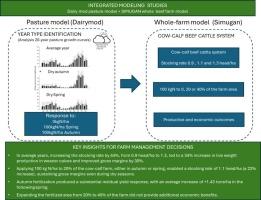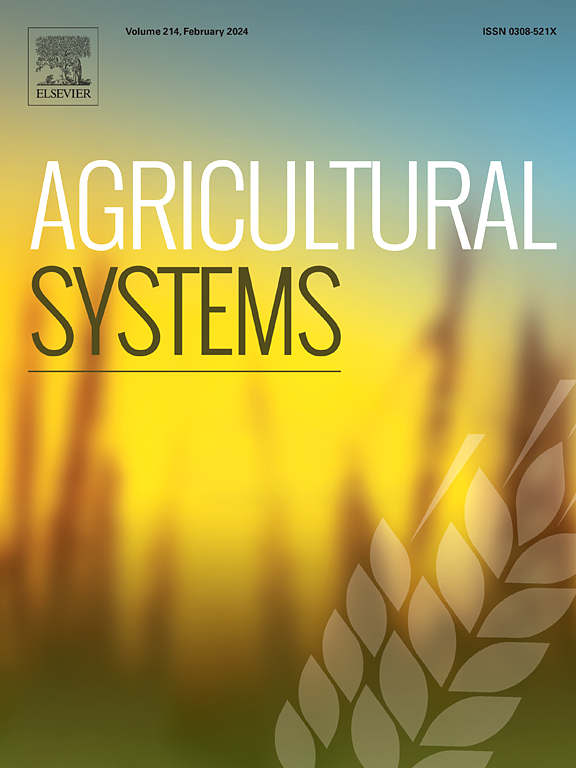Use of models for identification of nitrogen fertilization strategies for filling feeding gaps of cow-calf systems in the Flooding Pampas of Argentina
IF 6.1
1区 农林科学
Q1 AGRICULTURE, MULTIDISCIPLINARY
引用次数: 0
Abstract
CONTEXT
Nitrogen availability is the primary limitation for the growth of tall fescue, Argentina's most widely cultivated cool-season pasture. Significant yield gaps exist in fescue pastures on commercial farms, where average annual yields are around 5 t/ha, compared to a potential yield of 10 to 15 t/ha. Nitrogen fertilization remains uncommon among cow-calf producers, highlighting the need for a deeper understanding of the complex interactions between nitrogen fertilizer management, stocking rate, and grazing management at the whole-farm level. Considering annual and inter-annual variations in pasture growth could enable regional beef producers to make more informed decisions, improving pasture yield potential, utilization, and overall farm profitability.
OBJECTIVES
I) to identify if N fertilization in autumn can boost pasture growth rates as reliable source of extra feed in autumn and winter, taking into account climate variability, and II) to assess how this affects farm-level productivity and profitability.
METHODS
An integrated modelling approach, combining a pasture model with a farm system beef cattle model, was employed. Various N fertilizer options (specifically, 100 kg N/ha applied in either autumn or spring) were allocated to 20 % and 40 % of farm areas, across stocking rates ranging from 0.9 to 1.3 head/ha. Simulations were conducted over the long term (1993–2013), focusing on tall fescue pasture growth. Seasonal pasture growth curves were calculated for each year, with particular attention given to identifying average years as well as those with dry autumns or dry springs.
RESULTS AND CONCLUSIONS
In average years, increasing the stocking rate by 44 %, from 0.9 head/ha to 1.3, led to a 34 % increase in live weight production in weaner calves and improved gross margins by 30 %. Applying 100 kg N/ha to 20 % of the cow-calf farm, either in autumn or spring, enabled a stocking rate of 1.1 head/ha (a 22 % increase), sustaining gross margins even during dry seasons. Autumn fertilization produced a substantial residual yield response, with an average increase of +1.43 tons/ha in the following spring, and finally Expanding the fertilized area from 20 % to 40 % of the farm did not provide additional economic benefits.
SIGNIFICANCE
This study provides valuable, forward-looking insights into how nitrogen fertilization strategies can improve productivity and profitability of cow-calf farms in the Flooding Pampas, especially under variable seasonal climate conditions. While limitations and areas for future research are acknowledged, the findings may also offer practical guidance for boosting livestock productivity in similar environments.

利用模型确定氮肥施用策略,填补阿根廷泛滥潘帕斯草原奶牛饲养系统的缺口
背景高羊茅是阿根廷种植最广泛的冷季型牧草,氮的供应是其生长的主要限制因素。商业农场的高羊茅牧草产量差距很大,平均年产量约为 5 吨/公顷,而潜在产量为 10-15 吨/公顷。在牛犊生产者中,氮肥施用仍不常见,这突出表明需要更深入地了解氮肥管理、放养率和整个农场放牧管理之间复杂的相互作用。考虑到牧草生长的年度和年际变化,可使地区肉牛生产者做出更明智的决策,提高牧草的产量潜力、利用率和农场的整体盈利能力。方法采用综合建模方法,将牧草模型与农场系统肉牛模型相结合。在牧养率为 0.9 头/公顷到 1.3 头/公顷的牧场中,分别将 20% 和 40% 的牧场面积用于施用各种氮肥(具体而言,在秋季或春季施用 100 千克氮肥/公顷)。模拟时间跨度为长期(1993-2013 年),重点关注高羊茅牧草的生长情况。结果和结论在平均年份,将放养率从 0.9 头/公顷提高到 1.3 头/公顷,提高了 44%,断奶犊牛的活重产量提高了 34%,毛利率提高了 30%。在秋季或春季,对 20% 的牛犊场施用 100 千克氮/公顷,使存栏率达到 1.1 头/公顷(提高了 22%),即使在干旱季节也能维持毛利。最后,将施肥面积从牧场的 20% 扩大到 40%,并没有带来额外的经济效益。 意义本研究就氮肥施用策略如何提高泛滥潘帕斯草原牛场的生产率和盈利能力提供了宝贵的前瞻性见解,尤其是在多变的季节气候条件下。虽然研究的局限性和未来研究的领域值得肯定,但研究结果也可为类似环境下提高畜牧业生产率提供实用指导。
本文章由计算机程序翻译,如有差异,请以英文原文为准。
求助全文
约1分钟内获得全文
求助全文
来源期刊

Agricultural Systems
农林科学-农业综合
CiteScore
13.30
自引率
7.60%
发文量
174
审稿时长
30 days
期刊介绍:
Agricultural Systems is an international journal that deals with interactions - among the components of agricultural systems, among hierarchical levels of agricultural systems, between agricultural and other land use systems, and between agricultural systems and their natural, social and economic environments.
The scope includes the development and application of systems analysis methodologies in the following areas:
Systems approaches in the sustainable intensification of agriculture; pathways for sustainable intensification; crop-livestock integration; farm-level resource allocation; quantification of benefits and trade-offs at farm to landscape levels; integrative, participatory and dynamic modelling approaches for qualitative and quantitative assessments of agricultural systems and decision making;
The interactions between agricultural and non-agricultural landscapes; the multiple services of agricultural systems; food security and the environment;
Global change and adaptation science; transformational adaptations as driven by changes in climate, policy, values and attitudes influencing the design of farming systems;
Development and application of farming systems design tools and methods for impact, scenario and case study analysis; managing the complexities of dynamic agricultural systems; innovation systems and multi stakeholder arrangements that support or promote change and (or) inform policy decisions.
 求助内容:
求助内容: 应助结果提醒方式:
应助结果提醒方式:


